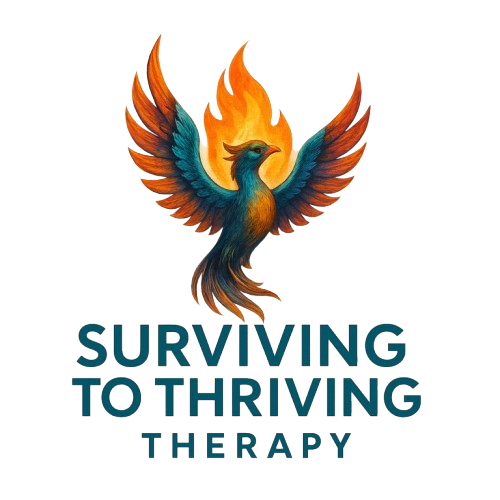
Our Areas of Expertise
From Guarded to Grounded: Creating Secure and Healthy Relationships After Trauma
Trauma-informed dating and self-awareness can transform relationships, build trust, and support lasting, healthy love.
Shifting Suicide Prevention: From Panic and Punishment to Trust and Strength
Every person thinking about suicide is carrying more strength than most of us can imagine. When we focus on that strength, prevention becomes about hope, trust, and collaboration—not control.
At the heart of suicide prevention is a simple truth: people want to live. When we honor that truth and support their strengths, real healing becomes possible.
Finding Hope and Balance When the Headlines Won’t Stop
You don’t have to carry the world’s grief to care about it. Taking a break from constant tragedy isn’t weakness — it’s self-preservation, and it gives you the strength to keep showing up when it matters most.
Beyond ‘Just Breathe’: Learning Skills and Building Strength Through TF-CBT
A few breaths won’t erase trauma or make overwhelming feelings magically disappear. Yet science tells us, skills like slow, steady breathing can calm your nervous system, give you a moment of relief, and create a tiny window for healing to begin.
That’s why Trauma-Focused Cognitive Behavioral Therapy (TF-CBT) moves slowly and intentionally. Over about 12–16 sessions, you’ll learn practical tools—like calming your nervous system, interrupting spiraling thoughts, and safely working through your trauma story with support. This gentle blend of cognitive-behavioral skills and trauma-sensitive practices helps you feel more grounded, regulate your emotions, and build coping skills that actually work for you.
I won’t sugarcoat it—trauma therapy can feel tough at times. Some weeks you might dread revisiting painful memories you’ve worked so hard to leave behind. That’s normal. But with steady support, you’ll discover self-compassion, resilience, and new ways of handling stress. You’re allowed to heal at your own pace, and over time you may notice yourself feeling steadier, more confident, and more equipped to handle life’s ups and downs.
Shifting Out of Our Conflict Patterns
In therapy, we’ll practice new ways of communicating and calming your nervous system so you feel more grounded when tensions rise. Like learning new steps in a dance, these skills gradually change the rhythm of your interactions, lower stress, and open the door to healthier, more respectful relationships. Over time, these small changes ripple outward—helping you feel more confident, connected, and hopeful.
Why You’re Not the Problem: How Therapy Can Miss the Mark on Marginalized Clients
Yet for so many people—especially those outside the dominant culture—therapy can feel like a space that misses key parts of who you are. Yet for so many people—especially those outside the dominant culture—therapy can feel like a space that misses key parts of who you are. So much of the mental health system was built without fully considering racism, discrimination, poverty, or other barriers, and that disconnect can leave you feeling unseen or even blamed for things that aren’t your fault.
Therapy with us isn’t about erasing your survival strategies or judging your choices—it’s about understanding where you’ve been, honoring your resilience, and helping you build new ways of coping at your pace. You’re welcome here exactly as you are, and we’re committed to creating a space where you feel seen, respected, and understood.
When Trauma Looks Like ADHD
Growing up in a stressful or unsafe environment leaves real marks on the nervous system. Behaviors often labeled as ADHD or “acting out” can actually be survival responses—hypervigilance, impulsivity, or intense emotions that once helped you stay safe. Seeing these patterns for what they are can shift shame into understanding. With therapies like EMDR or Internal Family Systems, you can gradually retrain your nervous system, ease the grip of old survival strategies, and respond to life from a calmer, more secure place. You’re not broken; your body adapted. And with support, it can adapt again.
It Made Sense at the Time: Understanding and Replacing Painful Coping Patterns
Every behavior tells a story. Even the habits people judge most—like drinking, using substances, or controlling food—once served a purpose. They were ways to cope, survive, or feel safe when life felt overwhelming. You’re not broken; you adapted. Therapy isn’t about shaming those patterns but about understanding them and discovering new, safer ways to meet your needs. Change takes courage, support, and time—but you deserve all three as you build a life that truly supports you.
Growing Up Queer: Turning Surviving Into Thriving
Growing up LGBTQIA+ can feel like walking through a world full of invisible rules, quiet judgments, and constant reminders that you don’t fit the mold. Yet surviving those years took courage, creativity, and resilience—and those same strengths can now help you heal and thrive
Attachment Wounds from Parents’ Mental Illness
No matter what you experienced growing up, it’s never too late to heal. If your childhood involved caring for a parent with mental health struggles or feeling unsafe and unseen, you can still build the stability, trust, and self-worth you deserved all along. Therapy can help you untangle old fears, soothe attachment wounds, and build the stability, trust, and self-worth you’ve always deserved.
Healing from Sex Trafficking
What you’ve survived does not define you—it reveals your strength. Sex trafficking may have stolen safety, trust, and identity, but it cannot erase your resilience or your right to heal. At our practice, we honor survivors as experts on their own lives and partner with you to rebuild confidence, reclaim your voice, and reconnect with your true self. With trauma-informed therapies, practical tools, and a supportive community, you can move beyond survival into growth, freedom, and a future you choose.
Creating Hope: Supporting LGBTQIA+ Suicide Attempt Survivors
Utah has one of the highest suicide rates in the nation, and the toll is heartbreaking—especially for LGBTQIA+ individuals and their families. At Surviving to Thriving Therapy, we’re dedicated to creating a safe, affirming space where people can share their stories, feel understood, and learn tools for healing. We meet clients where they are emotionally, mentally, and psychologically, helping them cope with suicidal thoughts, reduce risk factors, and build resilience. Most importantly, we believe suicide can be prevented—and that everyone deserves support, hope, and the chance to thrive.
Talking about Suicidal Thoughts
Talking about suicide is hard—but it can also be lifesaving. In my work, I’ve seen how open, compassionate conversations about suicidal thoughts give people relief, reduce shame, and open the door to real support. Rather than rushing to hospitalization or avoiding the topic out of fear, I focus on listening without judgment, asking clear, direct questions, and partnering with clients to create a plan for safety and healing. This collaborative approach helps people feel seen, builds trust, and gives them the tools and hope they need to move toward a life with less danger and more resilience.
EMDR: What to Expect
Starting EMDR can feel intimidating, but you don’t have to do it alone. This gentle, eight-phase process moves at your pace, with plenty of support to help you feel grounded and prepared. Together, we’ll build coping tools, create a sense of safety, and strengthen your ability to handle emotions before diving into the deeper work. With this foundation, EMDR becomes a safe and empowering way to heal old wounds and discover new resilience.
Introduction to EMDR
EMDR zeroes in on those powerful, emotionally charged memories that still shape how you see yourself and the world today—often showing up as tightness in your chest, a knot in your stomach, or other body sensations. By combining mindful attention to your thoughts, feelings, and physical reactions with targeted techniques, EMDR helps your brain reprocess past experiences and build new, healthier beliefs about yourself.
Excerpt from EMDR: Hate to Love It, Love to Hate It
EMDR can feel intense and even exhausting, but it’s also surprisingly transformative. In my own journey, I’ve learned that it’s not just about revisiting painful memories—it’s about building awareness, learning to regulate emotions, and uncovering insights that lead to real change. Even without completing every phase of EMDR, I’ve discovered tools like mindfulness, acceptance, and body awareness that help me stay grounded and live more in line with my values.
Suicide and Self-Harm: Helping People at Risk
Word choice matters. Some people don’t view their self-inflicted violence (SDV) as causing “harm.” Not all self-directed violence causes an injury. Not all self-directed violence is mutilation. If I ask a client if they’ve injured themselves, they might say no, despite having engaged in some sort of self-directed violent behavior. Also, not all self-directed violence is suicidal in nature.
Why are our graveyards full of rainbows?
The most frequent question I receive about queer youth suicide is about the role of the Church of Jesus Christ of Latter-day Saints in the problem. I would like to take this opportunity to provide data and context to the problem of youth suicide in Utah.


















